| ← Август 2025 | ||||||
|
1
|
2
|
3
|
||||
|---|---|---|---|---|---|---|
|
4
|
5
|
10
|
||||
|
12
|
13
|
14
|
15
|
16
|
17
|
|
|
20
|
22
|
23
|
24
|
|||
|
25
|
26
|
27
|
28
|
29
|
30
|
31
|
За последние 60 дней 22 выпусков (2-3 раза в неделю)
Сайт рассылки:
http://best.moy-forum.net/
Открыта:
10-08-2009
Статистика
0 за неделю
Production 4: Evolution
|
Production 4: Evolution 2025-08-11 12:40 alienshooter The motivation for writing the fourth part of the construction manual was several factors:
Eden Trade question at Fanfest In 2019, Eden Trade was farming agent 4 on a marauder, and he ran out of missiles, he did this on the outskirts. And when he opened the market to buy ammo, Eden saw that no one was selling them. Then he asked himself: "Why, for 20 years of Eve's existence, is Jita not in every region?" Like, for such a period of time, the game should have had, roughly speaking, the TV series "Babylon 5". Because of this, Eden started trading in 10-20 regions across the galaxy. And the sad news is that even after a few years, he is the only one who sells missiles for his Marauder. But for 20 years of the game's existence, the powerblocks were able to build Keepstar near Jita with a multi-billion dollar monthly income and divide the ISK from it equally among everyone. Of course, in the end they did not divide the ISK and later demolished it themselves. Next, in each region of the Pandemic Horde, they installed hundreds of iChooseYou Market. Roughly speaking, a monopoly. Then, in the 21st year, Fraternity produced 50% of all items in the game, their sales market is Jita. And the Goons market for sales is, accordingly, Amarr. Well, we do not remember the sawing of structures of solo players in highsec by pirates, or power blocks from alts, or pirates, at the request or funding from power blocks. Because it is a monopoly and competitors must be fought. Volume is not that important If we use the rating of all markets that currently exist in the game, we will notice an interesting feature: The main trading hubs - Jita, Amarr, Dodixie, Rens, Hek have at least 1 trillion volume of goods in sell and buy orders: https://dev.adam4eve.eu/market_hubs.php 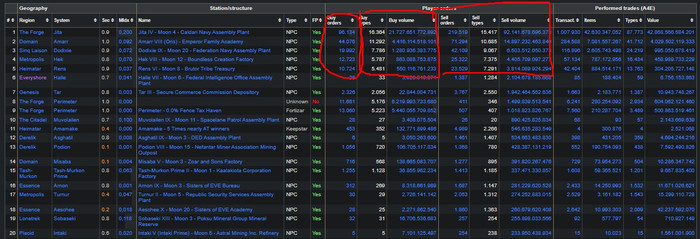 But is the total volume of goods so important if they are not sold? You have 100kk in assets, but the turnover is 100kk per month. Another example, you have 1kkk ISK in goods and the turnover there is 100kk per day. Of course, the second option is better. So, two parameters are actually important for the market, the ISK turnover and the number of trading operations: 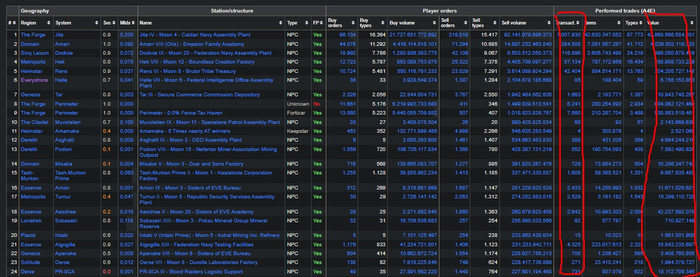 Specifically, the screenshot shows the turnover and trading operations for the last 7 days. You can filter the table by turnover or transactions to understand which are the most active markets in the game at the moment. Turnover rate and competition
Main article In short, when you have 100 blueprints or a set of goods that you build, production is established, and it even brings you some income, the question arises where to go next? How can you increase earnings or optimize the process? I bring to your attention the possible stages of construction evolution: Production stages Stage 1. Farm - 10, 100, 1000 blueprints available, but only 10 of them are enough to build. The reaction to order completion to build it again is very slow. Stage 2. Hauler - 10, 100, 1000 blueprints available, they are fully built, everything is sold on the market. Materials for construction are purchased in the trade hub and brought by truck. Hauler online, the reaction to order completion is slow. Stage 3. Automation - you have a buffer with materials for construction 10, 100, 1000 blueprints in the warehouse. The reaction to order completion is fast. Stage 4. Automation. Mark 2 - you have a buffer of finished items in the warehouse. The reaction to the completion of the order is very fast. Stage 5. Conveyor - the depth of orders that are sold allows you to assemble 100 fits of different types of ships at the station. Thus, you have time to react and build completed orders, and you also open the opportunity for fleets to gather at your market. Stage 6. Mega-factory - orders are boosted so that a full fleet of 250 pilots can gather at the station where you build. Stage 7. Industrial agglomeration - orders are boosted so that a full fleet of 250 pilots can gather at the structure where you build and another 250 fits are in reserve after the fleet is assembled in sell orders. The stage is unrealistic, if anything. And now, for each specific stage, but in more detail, and if you already understood everything, then you can stop reading o7 Stage 1. Farm In any way, mining, expeditions, scanning, agentrun, trading, etc. you earn ISK, for which you buy yourself blueprints improved in contracts, or improve them yourself, build items according to the blueprints and sell them. Everything is very simple, repeat this procedure until there are 100 blueprints or 10 billion in circulation. The wrong solution is not to stop and buy more and more blueprints, up to 1500 different items (according to OZ Eve at Fanfest, there are 40k different items in Eve, but only 1500 of them are in use). Because then you will always be at the farming stage, and you will endlessly mine ISK for construction. Imagine that in Factorio you have a bunch of bases, on all five planets, but the construction is not automated, and you just have to manually fill all the structures, it's the same here. Therefore, it is important to limit yourself to building a certain type or quantity of goods. For example, all T1 ammunition is 120 orders, or T1 rigs in use, about 80 orders. Or by building fits, such as: heron, scan launcher, plugs, scan rigs, data, relic, cargo scanner, engines, warp stabilizer, nano, inner stabilizers, damage controls, etc. And to the main core, add other scanners, such as probe, imicus, magnate, ventura, gas suckers for ventura miners, mining laser optimizers. Or you can limit yourself to ISK, for example, the volume is 10 billion. Which will allow you to move on to the next stage of construction. Because, remaining in construction as an eternal farmer, eternally young and eternally drunk, sooner or later you can burn out. Stage 2. Hauler Next, having decided on a set of goods, all of them are sold on the market by orders, the stage begins, where to get minerals for construction. Usually here people either farm ore themselves and understand that this is crap, or take a truck with the received ISK and buy minerals in Jita, take them back to the plant. At the trucker stage, you can become so full of your knowledge that you can training yourself 10 jump freighters and drive them non-stop from Jita and back. Earn a lot of ISK and eventually burn out, quit the game. How the guy did it in the interview with Oz Eve: EVE Online's largest industrialist - Interview with Sir SmashAlot https://www.youtube.com/watch?v=hGSHva5X6vc Stage 3. Automation You already have a set of blueprints, you learned how to buy materials for production in Jita and even bring them to the factory. What to do next? Let's simulate a situation, take a random region Verge Vendor:
And the purchase occurs depending on what you are building. If T1 items are minerals, T1 rigs are T1 salvage, T2 modules and ships are datacores, components, planetary, morphite, T1 items, T2 rigs are T2 salvage, components are reactions, etc. With a fixed set of blueprints, you can calculate how many materials you need to build them. For example:
But if you buy new blueprints for 10 billion instead of materials, then you will again find yourself at the farming stage with all the consequences with a lower turnover and profit, respectively. I do not recommend doing this. Regarding t2 construction, it is more difficult than t1 and rig because of:
In t2, 10 billion can easily turn into a full cycle of 30-40 billion, for automation and buffer in the warehouse. Lyrical digression I recently heard in a video, a person from powerblock claimed that if you can't build 1000 Hurricanes, then you are not a builder. But is it really so? How to get 1kk sp on main / Как получить на основу 1кк сп? On any account, even an old one, follow the link, and at the bottom under the fields, click "Log in to become a recruit". You don't need to fill out the form: 1млн навыков бесплатно сп / 1mln free skills. To build 1000 Hurricanes is:
It seems to me that this is primitive, and it is much cooler if you have automated construction like in Factorio, all the blueprints are planned in advance, you need to go to Jita once a month or not at all, a buffer of resources, compachs, reactions, etc. Now that's what you can really say, builder. Also, with a buffer of materials for construction, you insure yourself against invasions of drifters, pirates, Triglavs, gunkers, etc. Since there is no Jita or Amarr in your construction chain, or a very small percentage - for sanity, once a month. Stage 4. Automation. Mark 2 Congratulations, you don't go to the hub to buy stuff anymore or you do it very rarely. How can I boost the ISK turnover even more when I already have a buffer of resources for building in the storage? It's very simple (if I may say so) - you make a buffer from ready items! That is, 10 billion already turns into 20 with the purchase of resources and into 30 with the creation of a buffer in the storage. Why the hell do this? For example, you build all T1 cartridges and rockets, with a cycle of 7 days, someone flies in and buys the entire order from you! Now other buyers have to wait 7 days until you build the cartridges and put them up for sale again. Not very convenient, right? No one will wait 7 days. And what will happen when you additionally build not only in the order, but also in the storage: 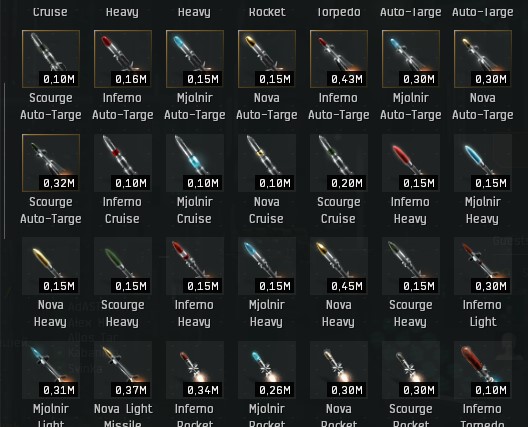 i.e. the order is over, you immediately put new missiles on sale and the blueprint that you took on construction. It is built in a week, while people calmly buy ammo for themselves, not upset that they are not available. Any supermarket in real life works on this principle. Put all the goods on the floor, fill everything that was disassembled again, shelves, and then do your own in the warehouse or chill. In T2 construction it is the same, with the T2 blueprint buffer you update the order from several hours to several days, and without it at least 7 days to update the goods for the sold out order. But that's not the limit, if anything, you can pre-build components in the warehouse there, or even reactions themselves for building compachs, if you need the "legendary masochist" achievement on steam. Stage 5. Conveyor Here you will begin to understand such a hat that it is easier to buy 100kk tritanium than 1kk. And it is easier to sell 10 nagas than one. The depth of your assortment. That is, if you built there more or less periodically, you could notice that before big battles there is always a mass purchase of ships, modules, rigs, and ammo. At the same time, the price does not always play a primary role, but the number of items in the position for sale is important. Also, a person will not bring you 1kk tritanium to earn 500k ISK. He will rather bring 100kk on a buy order and earn 50kk. Therefore, at the conveyor stage, there is a deepening of orders, the ability to buy and sell in bulk, at the station where you build. By the way, I forgot to say that with automation, you will notice an interesting joke - at the station where you are engaged in construction, buy resources and sell items, haulers and traders will start up. Because it is more convenient for the player when he can come, bring something to sell on a buy order, and buy from you on a sell, take it to sell at a higher price, so as not to drive empty. Traders and haulers will greatly revive the market and boost turnover. Stage 6. Mega-factory This is the builders' response to EVE streamers' complaints that there are no ships in Jita to assemble a fleet of up to 250 people. Hubs have often been empty lately, or ships are sold for three times the price. You can create competition with your factory and everyone will benefit from it. Stage 7. Industrial agglomeration The theoretical stage needs to be tested in practice. The idea is that you pay 500 PLEX monthly for factory rent to build something on it for 30 days. It's like a license, you can boost accounts with omega and build even faster, that's why many people do it. And here the idea is to go the other way around, to be able to set up so many assets in a month, so that later you can turn off factories for several months, waiting for the items to sell. Then turn them on again, and thereby save on omega. Is this realistic in practice, unfortunately I can neither confirm nor deny, check it yourself. o7 Second lyrical digression Let's talk about such a sore subject as Eve, war and competition. This mostly concerns Ukrainian players, that we can't compete with others in the game to the fullest extent, due to the fact that missiles and drones fly at night, and the lights go out periodically, due to shelling, sometimes it's on, sometimes it's off. I suggest treating this like running with weights on your arms and legs during a marathon. That is, everyone runs without weights, and we run with them, and it is not so easy. What is the advantage of such running, leaving aside the fact that it is not fair? I guarantee you 100% that you will outrun everyone when the weights are removed from your arms and legs. You will simply fly, overtaking everyone in front. This is the first thing. And secondly, the boomerang law works, everything you do sooner or later comes back to you and ultimately either the weights will be removed, or all the participants of this wonderful race will run in them o7 Now, regarding competition, comparing yourself with others, it is impossible to find peace. Since someone will always be better than you, so I suggest that in the game you compete first of all with yourself, this is the most healthy competition, to overcome yourself. By doing this, getting ahead of the rest will be an indirect result. 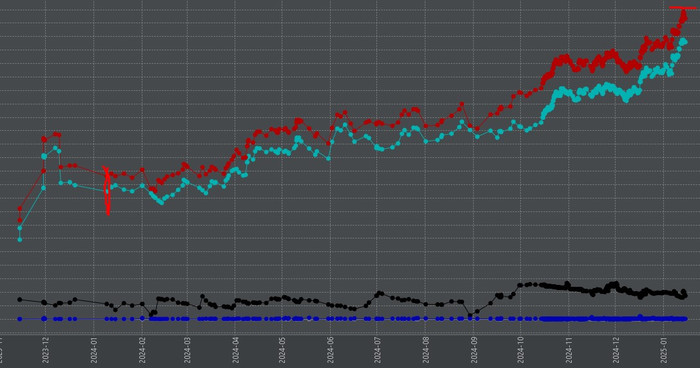 That is, for example, 10 conditional billions of ISK, compared to 120 trillion in Jita, is little, but if you had 5 billion a year ago, and now it's 10, then you are growing and have doubled your assets in construction in a year. In general, there is an English-speaking guy on YouTube who completed the game without ever buying Omega, he just made videos, they got views, he became a partner and they pay him Omega + 500 PLEX monthly. Further production development 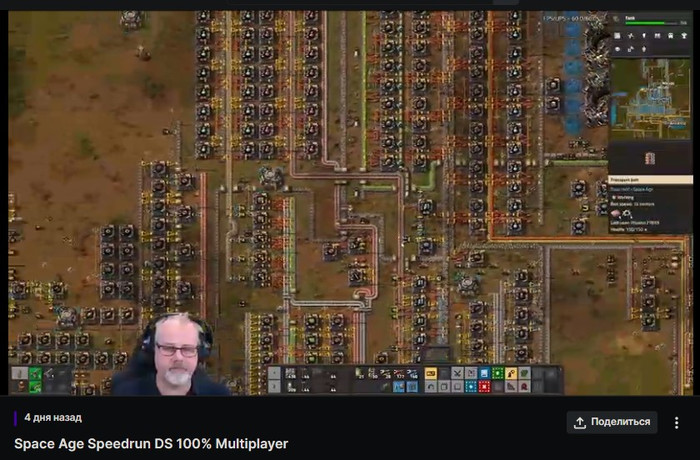 Space Age Speedrun DS 100% Multiplayer - nefrums on Twitch https://www.twitch.tv/videos/2351225288 An awesome topic, if you speedrun Factorio with ten people. The same can be done with construction in EVE at the expense of corporation projects. But how exactly, see for yourself o7 Production 5: Modernization 2025-08-11 14:01 alienshooter When manufacturing in Eve, sooner or later you will have to face the so-called "glass ceilings". Obviously, you may have noticed that for 30 inventory lines from one account, you don't need 30 production lines, but 60 or 90. And this, accordingly, means paying for another account, training it out, and an additional 500 PLEX for renting another factory every month. Then, for example, a rebalance patch comes out, and some type of resource: minerals, salvage, etc. becomes easier to collect, it becomes 25% cheaper, as was the case with morphite recently, and now to earn as much as before, you only need to build 25% more! Again, everything is solved by renting an additional factory and paying for another account, for a larger number of lines. Or you can go the way of improvement and modernization due to skills for anufacturing speed, implants, and of course citadels, which will be discussed in this article. I wanted, purely for myself, to calculate when it is profitable to install a structure, and in how long will it pay off in cost? We will gradually throw parameters into a heap and maybe in the end it will be possible to derive a formula for calculating the profit of installing citadels! 1) Types of structures The first Raitaru of our corporation was installed in one jump from Dodixie, following the example of Perimeter in Jita, with the aim of building cheaper goods than those that were sold at that time, 2020, I think. And for all the claims, in the end, it stood abandoned for six months, no one touched it. Then a patch came out where it was necessary to install expensive cores in the structures, and Raitaru died in the first wave of demolition of cytos due to cores from local Gallente pirates, who then moved to Amarr. Astrahus - 3 billion 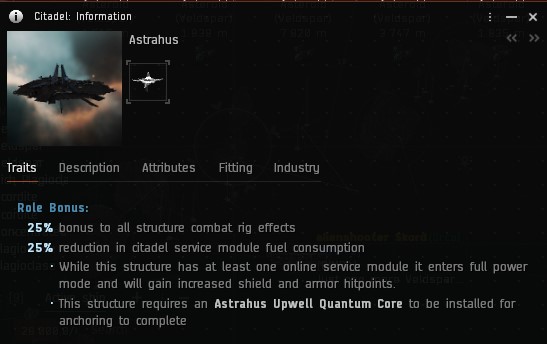 About 2-3 billion in fit, a discount on the cloning module for fuel and a bonus for combat rigs. Of all the medium structures, the most tanked and capable of equipped light fighters. Astrahus are installed so that there is an opportunity to dock often, these are wh, low, null, etc. where there are no NPC stations and cloning in the systems. Raitaru - 2kkk 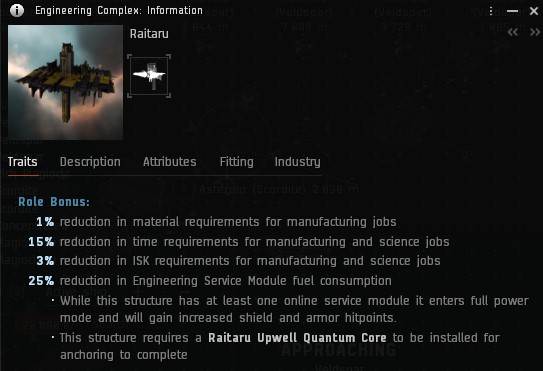 Own plant, compared to Astra is thin, but has good bonuses for production, namely:
In addition, with engineering rigs and space (low, high, null), you can significantly reduce your construction costs for materials. But, as you understand, such a hat as logistics appears. Athanor - 2 billion 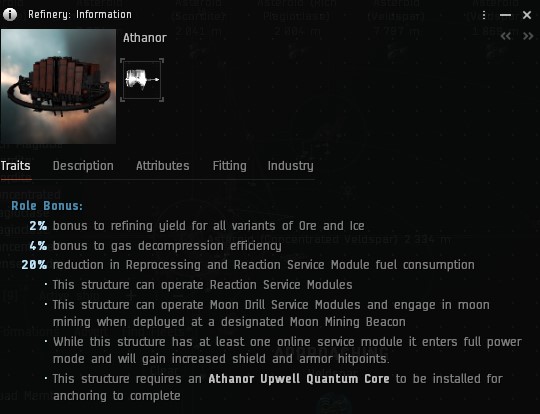 Everything related to the extraction of resources and their subsequent processing. Of the features:
Large structures are a feature of all large structures, the ability to stick a market, and 5 slots for modules. Additional reinforcement timer, armor. Fortizar - 20 billion 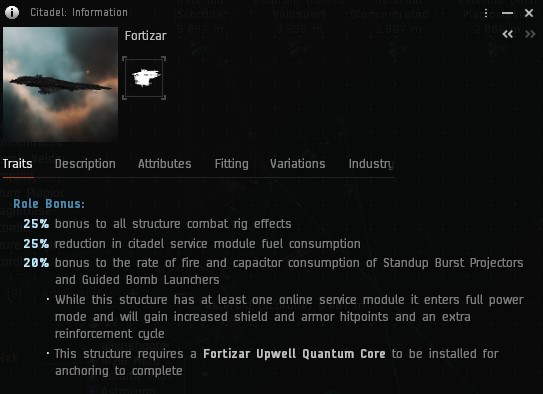 Astrahus's big brother, even more HP, fighters and attack modules. Like its predecessor, Fortizar is often used for strategic reasons. For example, in logistics, if I'm not mistaken, dreadnoughts can get to the fortizar. In wormhote in C2, for example, it is more difficult to evict from the fortizar than from the astrahus. An interesting topic of the fort is that the market module becomes available, this is 0% trading in plexes, injectors, extractors and free buy orders for any type of goods. And also large structures have "dual" rigs, with large bonuses compared to medium citas. Azbel - 10 billion 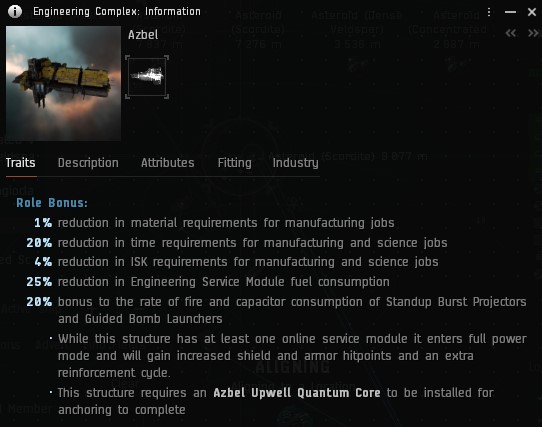 The elder brother of the raitary, from the new:
Tatara - 15 billion 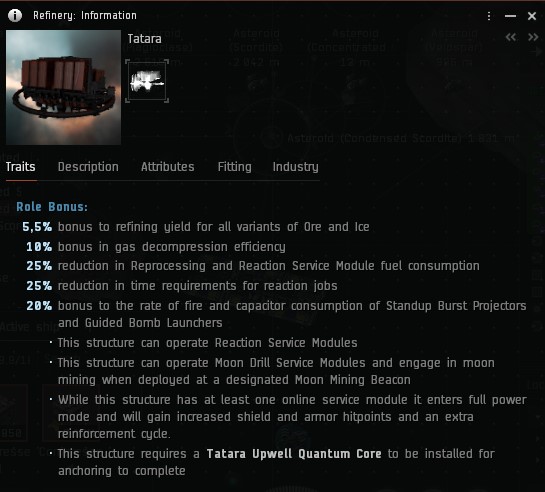 Improved version of Athanor, more tanking and better bonuses. It seems like in highs with a T2 rig you can get a max 75% yield from processing ore and ice, or even more?! For nothing to do, just for fun we'll add extra large structures. Of the features, you can't put them in highs. Titans and Supercars can be docked in Keepstar, and they can be produced on Sotiyo. Even better rigs with bonuses for construction and defense. More slots for modules. Sotiyo - 40 billion 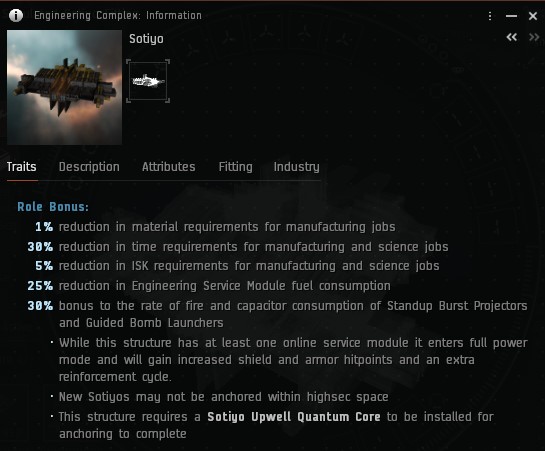 Max bonus for construction. Keepstar - 250 billion 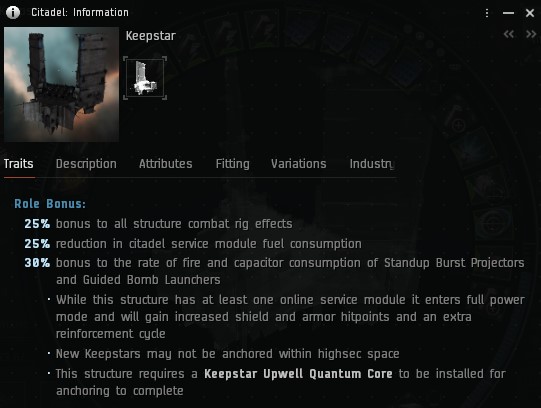 So, there is a certain set of structures with their cost. Let's move on to the next parameter on the list. How to get 1kk sp on main / Как получить на основу 1кк сп? On any account, even an old one, follow the link, and at the bottom under the fields, click "Log in to become a recruit". You don't need to fill out the form: 1млн навыков бесплатно сп / 1mln free skills. 2) Life cycle The second corp citadel was Astrahus in the highsector. It stood for one year, it came to installing a rig on it for building ships. In terms of costs, about 5 billion were spent on maintenance and about 50kk ISK in profit from taxes for using services. It was killed by highsector pirates, benders, a fleet of leshaks. In different parts of space, citadels live differently. Some for a long time, and some do not. You may be surprised, but the presence of a rig on a structure also shortens its life cycle. After all, the natural process of the free market sooner or later leads to a monopoly, the displacement of competitors, or even to unfair types of competition, in the form of sawing off a neighbor's structures. Let's take the pessimistic option that there is no fleet for protection and the tanking is on a timer for 3 am. Accordingly, now we will pass the citadels through various cosmos of New Eden, and see how long they will live: 1) Capitals of lowsec collectives. Unlucky, opened wormhole:
6) Wormhole C1:
Now, in addition to the cost of the structure, we also have a visual representation of its lifespan. For further comparison of results, you will need preparatory material: Activity "The third structure of the corp was Astrahus in Wormhole C1. It stood for one year, was cut out by a multiboxer on Eos and Nestors, 20-30 windows, no chance." All types of activities in Eve are divided into three types, like the structures listed above, you either:
All other activities, this can be said to be an addition to the three main ones above. The interesting thing is that the extractor can live on astrahus. For example, the same wormhole, he just farms and spends the night in the citka. And the merchant can use azbel, because there is a trading module enabled there, etc. The ratio "Athanor was the fourth corporate station, on it they mining the moon every week at 0.5 for several months until it was demolished by local lowsec pirates." Let's compare the prices of structures to their life cycle: 1) Capitals of lowsec collectives. Unsuccessful, opened wormhole:
Conclusion Having compared prices and relative lifetimes, we have received a minimum turnover per day from construction and trade, or profit from PVE extract classes, if the structure was installed for the convenience of farming. If the citadel was installed to get fun and fights, then it will be possible to clearly see how much of the opponent's ships need to be killed per day and how much time it takes for the costs of such fun to be justified. Thus, you can tank not only with a defense fleet or a 3-am timer, but also with turnover from the installed structure. Pay off the citadel faster than the pirates will destroy it. Install a new one and live on the difference. Fuel "The fifth citadel was again an astrahus in C1, stood for 30 days and was demolished by a solo guy in three windows, two marauders and a hauler with cap batteries. Which was then demolished by random guys, in his C1 dreadnought phoenix and fortizar, 2 months after the astrahus was washed away." It is important to mention that the calculations were made without a monthly fee for modules operating on the citadel. They can be added to the cost. Like taking the cost of the citadel per day and adding fuel costs. You get a clear minimum turnover, an indicator of when you can put the structure. Pandemic-Goons war 2025 With the sudden attack of the Goons on the Pandemics in June, the turnover in trade and production increased greatly. In 10 days, the turnover reached the monthly norm, and then returned to the normal summer minimum. It would have been possible to make x2 profit if there was a greater depth of orders, manufacturing lines, production capacities, or a buffer in the storage of finished items / raw materials. Interesting conclusion, those who produce / supply weapons for it love war the most, they will support it in every possible way so that it does not end. And the question of workers from a military factory in real life "When will we be able to earn so much money?" sad, but current reality. |
| В избранное | ||

